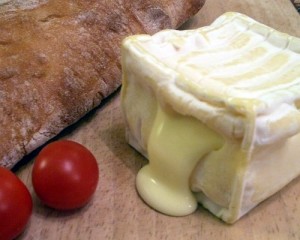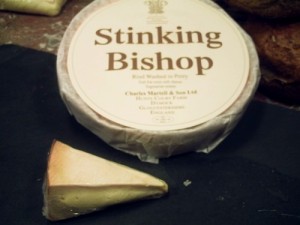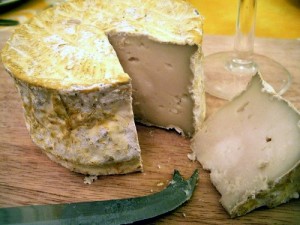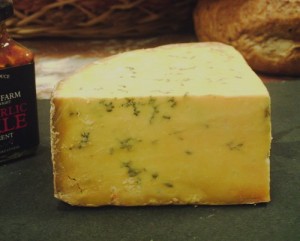Archive for April, 2013
Pavé d’Affinois
April 28th, 2013 Posted 5:54 pm
This delightful little offering was brought to our Sunday night cheesefest by Olympia’s cousin, Annabel on a recent visit.
It came in a little cardboard box, which had managed to adhere itself to the rind. As a result, the rind tore on opening, spilling it’s gooeyness on to the plate. It did, however, make for a good photo opportunity. ![]()
The name caused us a lttle confusion. Pavé is often used to descibe square slabs of French cheese, from French word for cobble or paving stone. However, there is no place called Affinois. We finally came to the conclusion that affinois is a word made up by the manufacturers to reflect its refined (affiner) ultrafiltration process.
It has pale ivory rind dusted with a bloomy white mould which smells mildy of ammonia and cow shed. The paste is gooey, almost liquid with scents of honey.
The texture is extremely decadent and the flavour very mild and a bit non-descript. However, when taken with wine, it releases the wonderful taste of honey.
Not tremendously exciting. It is labeled as “brie like”, and would make a more interesting replacement on the cheese board.
Purchased from Marks & Spencer.
Reviewed by Nick & Olympia (with guest reviewer Annabel).




 (2.5/5)
(2.5/5)
Posted in 2 Stars - OK, Cow's milk, French, Soft
Stinking Bishop
April 22nd, 2013 Posted 12:07 am
Made famous by the Wallace and Gromit film “Curse of the Were-rabbit”, this is one of, sadly, few English washed rind cheeses. The practice of washing cheeses was developed by monks, which, when king Henry VIII wiped out the monasteries, also died out.
Washing cheeses enriches the flavour and has the side effect of making the cheese very smelly. (Epoisses, possibly being the most notable. Washed in brandy and banned on the Paris metro because of the resultant pungent aroma.)
Stinking Bishop cheese is washed in perry (pear cider) made from Stinking Bishop pears, the colloquial name for the Moorcroft variety. This pear was apparently grown by a Mr. Bishop, who, by some accounts, was not a particularly pleasant character.
All this aside, does it actually live up to its name? Well, yes and no. Most washed cheeses are smelly, and this is no exception, but it isn’t as overpowering as the name suggests. Even a ripe Camembert would beat it in it’s nostril assailing quality. That said, you probably wouldn’t want to sit in the car with one of these in the picnic hamper, on a hot summer day without the windows open.
Like most washed cheeses, the rind is sticky, with a pale pink/orange colouration. The texture is gooey, but has a slight “bounce” to it. The flavour is actually quite mild. Smooth and creamy with a slightly bitter after taste. It’s pleasant enough, but nothing special.
The main appeal of this cheese is the kudos of having tried it or serving it up to friends on the cheese board.
Reviewed by Nick & Olympia, 2011.




 (3/5)
(3/5)
Posted in 3 Stars - Good, Cow's milk, English, Soft, Washed
Gleann Oir
April 14th, 2013 Posted 8:51 pm
This rugged looking cheese from Tipperary, covered with white mould flecked with yellow may look a little off-putting to all but the ardent cheese buff. It is, however, one of those cheeses that may convert those that turn their noses up based on appearances.
The strong smell of ammonia given off by its gnarled rind, some may also find offensive, but it is worth persevering.
The pinkish, grey interior is soft and waxy with very little smell, just a gentle hint of goat.
It has a delicate, very pleasing flavour a bit like Morbier with a wonderful nuttyness and farmyard flavour. Wine brings out the goatiness which, otherwise would not be apparent. All together a very satisfying experience.
Purchased from Cheese Please, Lewes.
Reviewed by Nick & Olympia, 2012




 (4.5/5)
(4.5/5)
Posted in 4 Stars - Very Good, Goat's milk, Hard, Irish
Shropshire Blue
April 2nd, 2013 Posted 4:52 pm
| Despite its name, Shropshire Blue was invented in Inverness, and according to our sources, no Shropshire Blue is actually made in Shropshire. 8OColoured with annatto, this cheese has a wonderful golden orange colour with starkly contrasting blue/green veins.
It is based on the Stilton recipe and, other than its colour, is very similar in appearance and texture. Hard and crumbly with a gnarled greyish rind. The smell is similar too, though there are overtones of caramel. This characteristic also comes through in the flavour, which is again similar, but not as strong and acidic as Stilton. It has a very “blue” flavour, yet it is smooth and creamy with none of that aggressive Stilton “bite”. All in all a very pleasant cheese and well work seeking out. It’s not too difficult to find and can be found in some supermarkets. It keeps well, so the quality seems to be fairly consistent. |
Reviewed by Nick & Olympia 2010




 (4/5)
(4/5)
Posted in 4 Stars - Very Good, Blue, Cow's milk, English, Hard




